Scratch 2-Stage EMRR Challenger Original Design / Scratch Built
Scratch - 2-Stage EMRR Challenger {Scratch}
Contributed by Eldred Pickett
| Manufacturer: | Scratch |
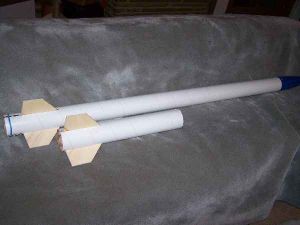
Brief:
For the EMRR Staging Challenge, I decided to build a two-stage rocket with composite motors. Since I had done a
2-stage before, I figured it would be easy. WRONG... I decided to do a 3-inch bird with dual deploy and a 19-inch
booster with motor deployment.
Construction:
This time I decided to use alignment rods in the stage coupler to keep the rocket aligned. I didn't have any
'sleeves' for the rods to slide through, so I went with spaced centering rings with holes to guide the rods. I've
discovered that I really need a drill press. Because I was using a handheld power drill, I wasn't that accurate in
drilling holes through the 2 sustainer centering rings and the staging coupler. It still works, but it isn't pretty.
There are holes in both centering rings that are supposed to be aligned. That didn't work out as smoothly as I had hoped.
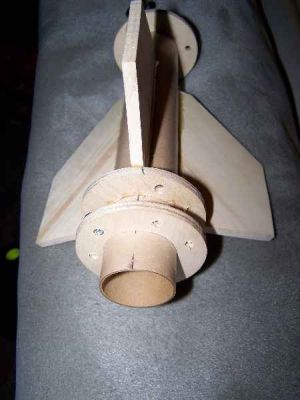
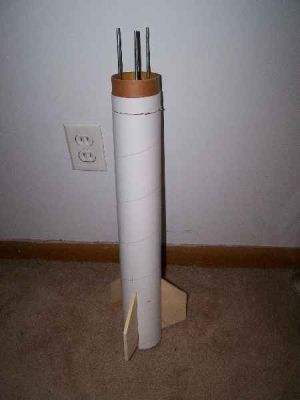
The motor mount is recessed into the sustainer to provide a connection for the top half of the stage coupler. Since a 3" tube won't allow me to get my hand in to connect the shock cord, I made the fin can on both the sustainer and booster removable. The sustainer fin can is held in place by small screws. The booster fin can will eject and deploy the booster chute. The whole project is about 83 inches tall, about 3.5 lbs empty, and can fly on 38mm motors.
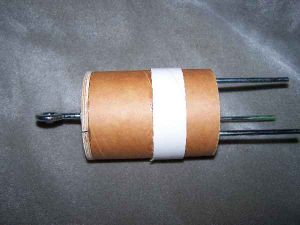
Finishing:
The fit/finish between the booster and the stage coupler is a little rough, but once it's painted it might not be
that noticeable. It *certainly* won't be noticeable on the pad.
Flight:
Electronics will be a PerfectFlite timer for staging, and a PerfectFlite MAWD for deployment. RockSim says it will
get to a little higher than 2000 feet with a CTI 153 staging to a CTI G79ss.
For the 2-stage challenge, I decided to build one that used composite motors. Since I have done staging before, I didn't expect there to be a problem. Boy, was I wrong... The main problem is the size of the new project. The previous 2-stager was almost a 4" tube. That left room for the timer between the sustainer fins, and a standard-type ebay. This one is a 3", and there's no room in the fincan. So I put the timer in the ebay, and ran a connector wire down to ignite the sustainer motor. I had to splice the wire so it would disconnect when the apogee event fired. The next issue I ran into was the stage connector. I decided to use metal rods to connect and align the sustainer to the stage connector. I don't have a drill press, so my holes through the centering rings are...less than exact. Last issue was the 3" bay was too small to use switches to power on everything, so I had to run all the wires through a hole in the e-bay and twist them to connect. That posed a problem the first time I tried to launch. I test fit the electronics when I built the bay, but nothing was connected. In the field, I sadly discovered there wasn't enough space for all the wires to fit and route to the outside. I had to rebuild the sled to avoid that problem for the next attempt.
The field we used has a waiver of 5000', but I wanted to make sure I kept the flight much lower than that. RockSim 7 showed an altitude of about 3800 feet on a CTI H143/G79ss combo.
Electronics: ARTS board for apogee/main deployment of the sustainer, PerfectFlite timer for sustainer motor. The booster recovers under its own chute by motor ejection. Payload: BoosterVision GearCam taped to the side. Crude, but effective.
Launch day: I racked the rocket, set up the breakwire, and twisted the wires for power. Since I didn't have enough room to push the wires back into the bay, I taped them to the outside. That was a mistake... The launch was beautiful! Straight, and staged on cue. The booster chute came out and it drifted down safely. The sustainer had a good apogee event(drogueless), but I lost sight of it while following the booster. There was no main deployment, and fellow club members pointed me in the direction they saw it fall. While walking out for recovery, I tried to figure out what went wrong. Too many sheer pins? Not enough BP? When I got to it, I immediately knew what happened. The arming wires were taped to the bottom of the sustainer. When the apogee separation occured, it ripped the wires out of the altimeter, killing power. AUGH! I powered up the ARTS board later, and the data showed 1700 ft accel, 1500 baro. WAY short of Rocksim's prediction, so the loss of power probably scrambled the data. But other than the ebay being crunched, and the booster being scorched by the sustainer motor, it didn't come out too bad. I can replace the ebay and fly it again.
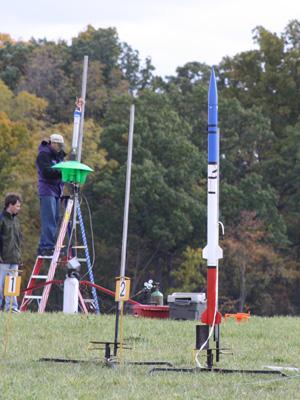
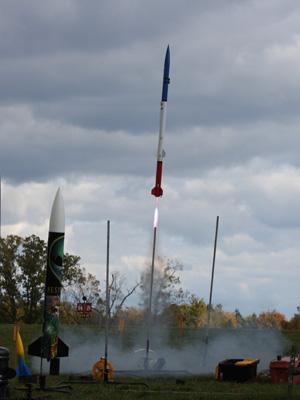
 |
 |